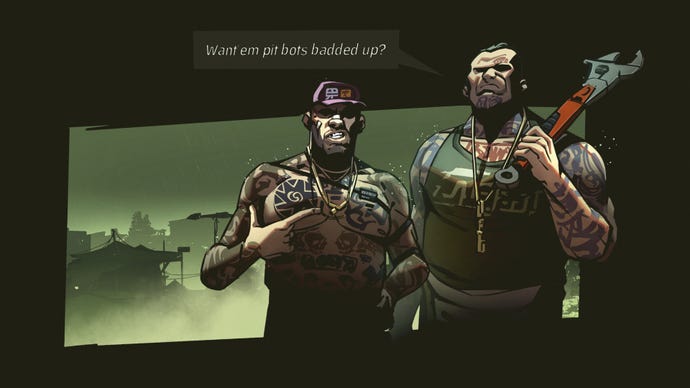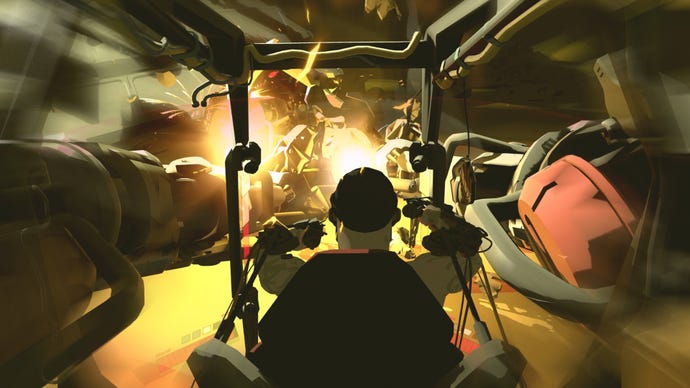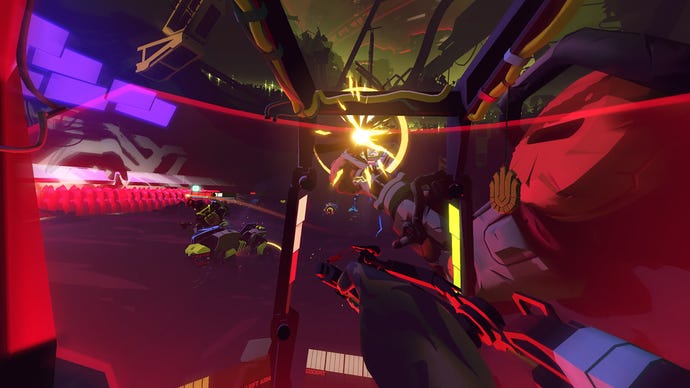Reality Bytes: Underdogs is the undisputed champion of the VR arena fighter
Thrilla in Gorilla
It's been a while since I played a game as effortlessly cool as Underdogs. This VR mech-fighting game has you pilot a giant mechanical gorilla, pummelling robots and human-controlled mechs with arms the length of lorries in grungy, trap-filled arenas. The combat alone is chest-thumpingly good, but Underdogs couples it with a fantastically evocative cyberpunk setting, and a smartly implemented rogue-like structure.
Before the show kicks off proper, a quick preamble from the pundits. This is the first VR game I've played using Valve's new(ish) Steam Link feature, and speaking as a Quest user, it does a far better job of letting you play Steam VR games wirelessly than Oculus Air Link does. For starters, you no longer need to load up the Oculus App before Steam VR, reducing the number of menu overlays you need to work through from three to two.
Moreover, the experience Steam Link offers is much smoother and more stable than Air Link. The last few games I played with Air Link constantly devolved into an unplayable slideshow, while checking any menu threatened to crash the game entirely. Switching to Steam Link was paddling a canoe across a pond after dragging the thing over two miles of rocks. Steam Link does require you to download the app onto your Oculus headset, but that's a small inconvenience for the improved experience it offers.
Right, onto the main event. In the red corner, we have Rigg and his younger brother King. Rigg is a talented but unlicensed mech fighter. King is a whizz hacker who broke into the mainframe of the world's authoritarian AI to forge a fighting license. In the blue corner, meanwhile, is that AI, which subsequently painted a target on King's back and is persistently trying to counter-hack into his cybernetically enhanced mind. Hunted, the pair flee to New Brakka, the only human-controlled city on the planet, which also happens to be the hub for brutal underground mech fights. The plan is simple: rise to the top of the ranks so they can get afford the tech needed to get King out from under the AI's thumb.
Written out like that, the plot sounds a bit daft. But Underdogs tells it so well that it cruises past any logical inconsistencies. The story's related through static comic-book panels drawn in a heavily inked shading style a-la Darkest Dungeon. These are all presented to capitalise upon VR's sense of scale and perspective, the game playing with them panel-to-panel just as a physical comic book would. The script, meanwhile, is written and voiced in a naturalistic MLE dialect that works superbly in the game's grimy cyberpunk setting. The effect is that, even though you never actively experience this world outside of fights, it feels like a fleshed out, believable place, one that arguably has a more coherent identity than a certain other, glossier cyberpunk game.
As for what you do in this world, the short answer is "fight". Each run has you climbing a ladder of arena-based matches, restarting at the bottom if you fall off. You experience these fights from inside the cockpit of the Gorilla (aka 'Rilla') Rigg and King's homemade war machine. Attacking an enemy while inside the Rilla is as simple as swinging your arms at it, with the Rilla's gangly metal limbs mimicking your movements.


Fighting effectively, however, is more complicated. For starters, the game tracks damage based on the arc of your punch, so straight, karate-style forward thrusts won't do much good here. Instead, you're after big, overarm haymakers, the kind that'll have your shoulders and triceps burning the following day. In addition, you don't just use your arms to attack, you also use them to move, dragging yourself forward on your knuckles. You can use this same manoeuvre to bash your opponent with your chest, which can do more damage than punching and knock enemies off their feet. But it also exposes your cockpit to potential damage, and since you can't really block attacks (at least, not initially), you need to time chest-bashes carefully to avoid collateral damage.
All of this gives Underdogs' scraps a distinctive flavour. In the thick of battle, you really do feel like a rampaging silverback, lumbering forward with your arms, barrelling enemies over with your chest, and then slamming them repeatedly while they're on the ground. It's kinetic, tactile, and deeply satisfying. The dynamic commentary from your kid bradda is excellent too. He gees you up when you land a good strike, frets when you take damage. His lines are a great personal touch amid the roar of the silhouetted crowd.
Each rung of the game's challenge ladder features several exhibition matches before you battle that particular area's boss. These earlier bouts pit you against nonhuman enemies like mechanical pit-dogs and beetle-like robots. These are fun to fight, although the challenge here as much about crowd control as it is combat technique. The boss fights against other mechs are undoubtedly the highlight, animalistic boxing matches where you duck and weave to avoid their attacks, find a gap to land some of your own, and panic when they inevitably unleash their second-phase gimmick.

In between fights, you return to a small turn-based map where you can repair your mech and buy new upgrades for it. There's nothing radical going on here, but Underdogs uses these quieter moments to add further colour to the world, mixing this preparation phase with random story events. In one example, a mechanic I visited accidentally botched my mech's repair, panicked, took off, and disappeared forever.
There are a couple of minor quibbles. I wish Underdogs let you adjust your mech's equipment at any point during the preparation phase, rather than forcing you to wait until just before a fight. This is mainly because you might receive or buy some cool new tech right away during this phase, then forget to equip it when it's fighting time. Also, selecting locations to visit during prep can be unnecessarily fiddly, with the controllers sometimes struggling to highlight menu icons.
Nonetheless, Underdogs is comfortably the most enjoyable VR game I've played this year, a distinctive, exciting first-person brawler with a cyberpunk setting that hits every bit as hard as its synthetic simian slugger. Move over, Blade & Sorcery, there's a new contender in town.









